NVIDIA GeForce GTX 690 Review: Ultra Expensive, Ultra Rare, Ultra Fast
by Ryan Smith on May 3, 2012 9:00 AM ESTOverclocked: Power, Temperature, & Noise
Our final task is our look at GTX 690’s overclocking capabilities. NVIDIA has told us that with GTX 690 they weren’t just looking to duplicate GTX 680 SLI’s performance, but also its overclocking capabilities. This is quite the lofty goal, since with GTX 690 NVIDIA is effectively packing 2 680s into the same amount of space, leaving far less space for VRM circuitry and trace routing.
| GeForce 600 Series Overclocking | ||||
| GTX 690 | GTX 680 | |||
| Shipping Core Clock | 915MHz | 1006MHz | ||
| Shipping Max Boost Clock | 1058MHz | 1110MHz | ||
| Shipping Memory Clock | 6GHz | 6GHz | ||
| Shipping Max Boost Voltage | 1.175v | 1.175v | ||
| Overclock Core Clock | 1040MHz | 1106MHz | ||
| Overclock Max Boost Clock | 1183MHz | 1210MHz | ||
| Overclock Memory Clock | 7GHz | 6.5GHz | ||
| Overclock Max Boost Voltage | 1.175v | 1.175v | ||
In practice NVIDIA has not quite kept up with GTX 680, and in other ways completely exceeded it. When it comes to the core clock we didn’t quite reach parity with our reference GTX 680; the GTX 680’s highest boost clock bin could hit 1210MHz, while the GTX 690’s highest boost clock bin topped out at 1183MHz, some 27MHz (2%) slower.
On the other hand, our memory overclock is so high as to be within the “this doesn’t seem physically possible” range. As we have discussed time and time again, GDDR5 memory busses are difficult to run at high clocks on a good day, never mind a bad day. With GF110 NVIDIA couldn’t get too far past 4GHz, and even with GTX 680 NVIDIA was only shipping at 6GHz.
It would appear that no one has told NVIDIA’s engineers that 7GHz is supposed to be impossible, and as a result they’ve gone and done the unthinkable. Some of this is certainly down to the luck of the draw, but it doesn’t change the fact that our GTX 690 passed every last stability test we could throw at it at 7GHz. And what makes this particularly interesting is the difference between the GTX 680 and the GTX 690 – both are equipped with 6GHz GDDR5 RAM, but while the GTX 680 is equipped with Hynix the GTX 690 is equipped with Samsung. Perhaps the key to all of this is the Samsung RAM?
In any case, our final result was a +125MHz core clock offset and a +1000MHz memory clock offset, which translates into a base clock of 1040MHz, a max boost clock of 1183MHz, and a memory clock of 7GHz. This represents a 12%-14% core overclock and a 17% memory overclock, which is going to be enough to put quite the pep in the GTX 690’s step.
As always we’re going to start our look at overclocking in reverse, beginning with power, temperature, and noise. For the purpose of our testing we’ve tested our GTX 690 at two different settings: at stock clocks with the power target set to 135% (GTX 690 PT), and with our custom overclock alongside the same 135% power target (GTX 690 OC). This allows us to look at both full overclocking and the safer option of merely maxing out the boost clocks for all they’re worth.
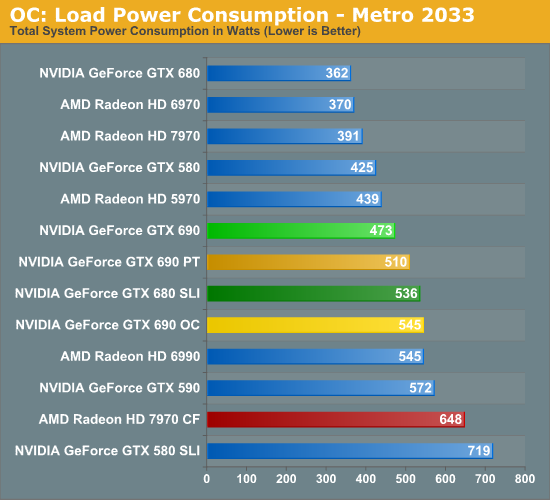

As expected, merely increasing the power target to 135% was enough to increase the GTX 690’s power consumption, though overclocking further adds to that. Even with the power target increase however, the power consumption at the wall for the GTX 690 is still lower than the GTX 680 SLI by over 20W, which is quite impressive. As we’ll see in our section on performance this is more than enough to erase the GTX 690’s performance gap, meaning at this point its still consuming less power than the GTX 680 SLI while offering better performance than its dual-card cousin.
It’s only after outright overclocking that we finally see power consumption equalize with the GTX 680 SLI. The overclocked GTX 690 is within 10W of the GTX 680 SLI, though as we’ll see the performance is notably higher.
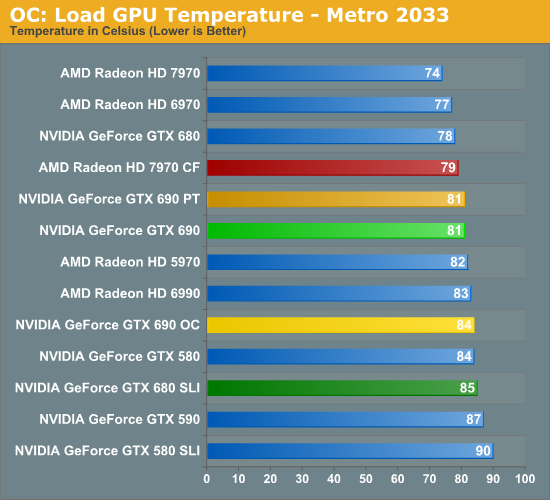
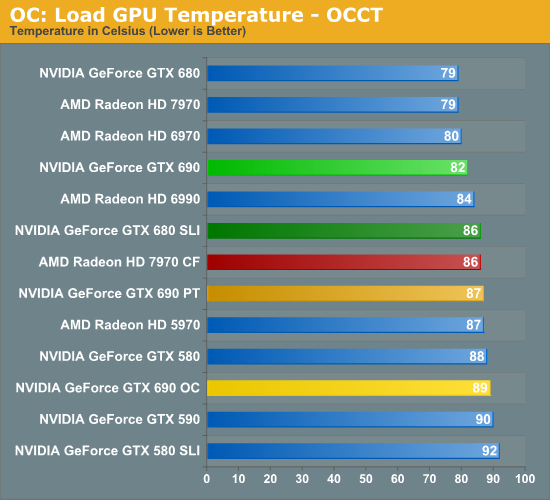
What does playing with clocks and the power target do to temperatures? The impact isn’t particularly bad, though we’re definitely reaching the highest temperatures we really want to hit. For the GTX 690 PT things are actually quite good under Metro, with the temperature not budging an inch even with the higher power consumption. Under OCCT however temperatures have risen 5C to 87C. Meanwhile the GTX 690 OC reaches 84C under Metro and a toasty 89C under Metro. These should be safe temperatures, but I would not want to cross 90C for any extended period of time.
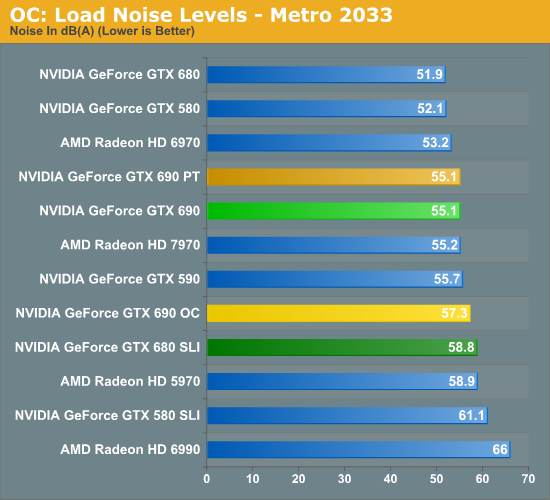
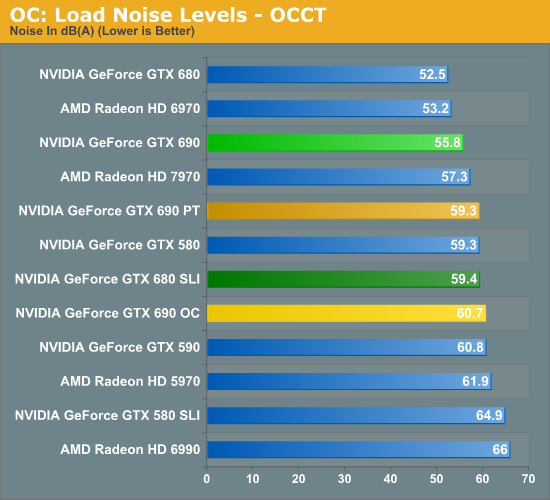
Finally we have load noise. Unsurprisingly, because load temperatures did not go up for the GTX 690 PT under Metro load noise has not gone up either. On the other hand load noise under OCCT has gone up 3.5dB, making the GTX 690 PT just as loud as our GTX 680 SLI in its adjacent configuration. In practice the noise impact from raising the power target is going trend closer to Metro than OCCT, but Metro is likely an overly optimistic scenario; there’s going to be at least a small increase in noise here.
The GTX 690 OC meanwhile approaches the noise level of the GTX 680 SLI under Metro, and shoots past it under OCCT. Considering the performance payoff some users will no doubt find this worth the noise, but it should be clear that overclocking like this means sacrificing the stock GTX 690’s quietness.










200 Comments
View All Comments
Death666Angel - Thursday, May 3, 2012 - link
Hey guys!Thanks for the article, I enjoyed the read (although I am not in the market for dual GPU configurations after trying the HD3870X2 and 2*8800GTS, happy with one 7970 OC'ed to the max.). But you seem to be missing the numbers for noise from the HD7970 in a CF configuration. I hope you can post them! :D
-DA
Ryan Smith - Thursday, May 3, 2012 - link
This was mentioned on the Test page, but we don't have a matching pair of 7970 cards; what we have is a reference card and an XFX 7970 BEDD. Power and temperature are the same regardless, but it would be improper to list noise because of the completely different acoustic properties of the BEDD.Mygaffer - Thursday, May 3, 2012 - link
How does that stack up, especially price/performance? Why didn't your conclusion address that question at all? Totally limits the usefulness of the review in my opinion.rs2 - Thursday, May 3, 2012 - link
As per the data in your article, the GTX690 is clocked 10% below the GTX680, and has a 5% lower boost clock. This may be a small compromise, but it is a compromise nonetheless.More accuracy and less hyperbole, please.
pixelstuff - Thursday, May 3, 2012 - link
Seems to me they should be saving money in the construction when compared to two 680 in SLI. Half the fans, half the connectors, have the circuit boards. They should have at least cut $50 off the suggested retail price.Also when will be see 3 of these running in SLI form?
Holler - Thursday, May 3, 2012 - link
you won't only one SLI connector.
not that impressed, i'll be holding on to my overclocked 1.5 GB TRI-SLI GTX 480 hydro coppers for the forseeable future, this card should atleast double the RAM it has now...
CeriseCogburn - Saturday, May 5, 2012 - link
Half the magnesium, half the aluminum, half the PLX chips, half the R&D, half the vapor chambers, half the chip binning, half the power circuits, half the copper pcb's.... oh no wait, all those are added expenses, not reductions...+
I guess they should be charging $200 over the 2x$499 dollar usual price.
See how actually using the facts, instead of sourpuss emotion delivers a different picture ?
will54 - Friday, May 4, 2012 - link
These cards are sold out on Newegg for $1200 per. talk about taking advantage on a 20% markup over the msrp,hopefully AMD knocks the prices way down when they bring out there 7990, $800 sounds about right.faster - Friday, May 4, 2012 - link
Now I need a new keyboard because I was drooling into mine as I read this review. I have a GTX 680, but I don;t like to run SLI setups - I had a bad experience with my dual 560ti's. This looks like a truly awesome card that would hold its value for resale later. Nevertheless, there is no way I'm spending a grand on a video card.Origin32 - Saturday, May 5, 2012 - link
I predict that the 790 will, finally, be able to run Crysis. Next year an era will end. Enjoy it while it lasts, folks.